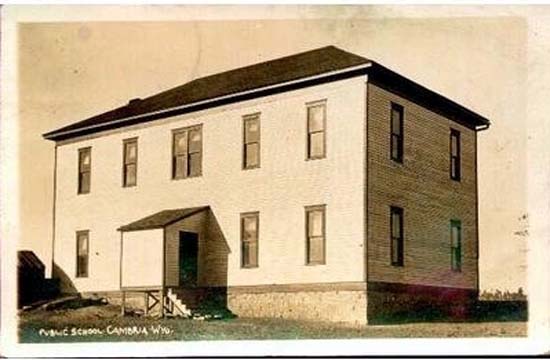
Cambria School, 1910.
The school house was located on top of the canyon. Students, therefore, had to climb up
some 365 steps to get to the school.
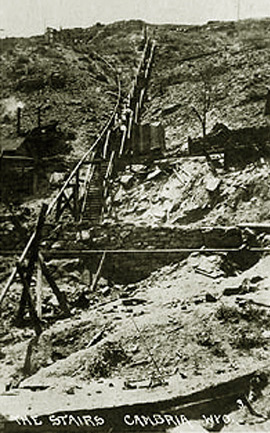 . . . . . .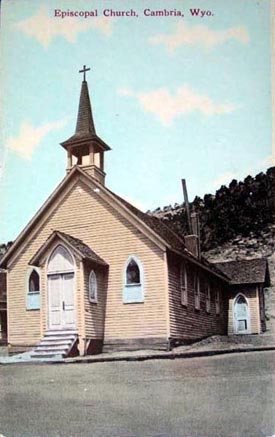
Left, Stairs leading to top of canyon
Right, Episcopal Church
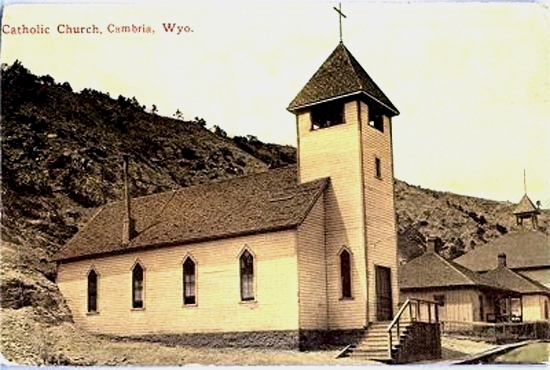
St. James Roman Catholic Church, Cambria.
The first Catholic services in Cambria were conducted in 1891 on a periodic basis by
the Reverend P. Cassidy from Hot Springs, South Dakota. The church building was
constructed in 1903 under the leadership of the Reverend P. J. Lynch. The building constructed
on land leased from the coal company under a 99 year lease cost $2,000.00. Initially, church services
could be best desribed as sporatic. Thus, regardless of denomination when a visiting priest or
minister conducted services, many would attend. The Right Reverend Ethelbert Talbot,
Episcopal Bishop of Wyoming, later recalled a pastoral visit to Cambria. He noted that many of the
miners were Italian. Nevertheless, the following day on the train leaving town one of the miners whose
command of English was less that perfect recognized the bishop from the services the
night before. The miner felt compelled to complement the bishop:
"Ah, you ze cardinal. I hear you talk last night.
Damn pretty church! Damn big crowd! Damn good talk!" Talbot, Ethelbert"My People of the Plains, Harper & Brothers, New York, 1906.
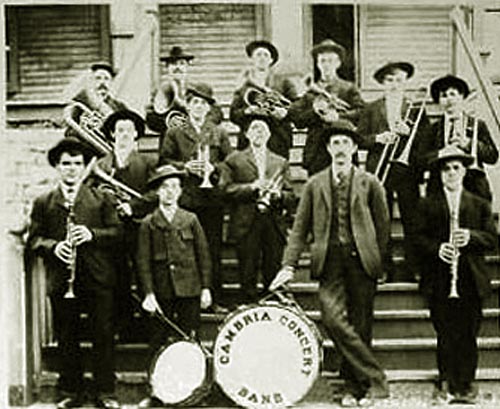
Cambria Concert Band, undated.
For the most part, entertainment in the coal camps was self created. Thus, in most coal camps there was a band. Although dances
might be held. At first there was a distinct dirth of women. Thus, Frank Mondell in his memoirs recalled a Christmas square dance
at Cambria in 1887 at which there was only seven women. To get enough, an individual identified as
Big Mike filled in wearing a red bandana. Music was provided by a band consisting of a harmonica and a fiddle.
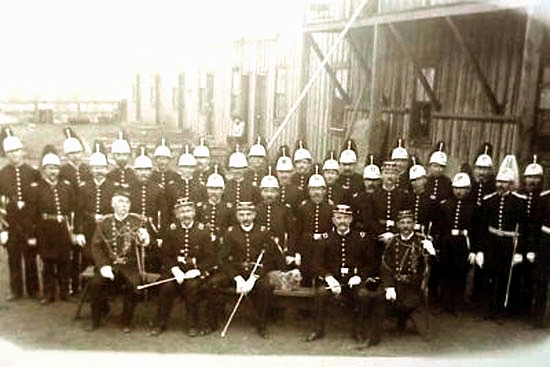
Charter Class, Knights of Pythias, Cambria, 1893, photo by
George R. Shane.
Social life was, thus, filled by fraternal lodges. In Cambria there were three,
the Improved Order of Redmen, Odd Fellows, and Knights of Pythias.
Seated in the front row are the installing officers representing the Grand Lodge. Included among the
installing officers from Deadwood Lodge No. 5, K. of P., are Edward McDonald, Solomon Star, J. F. Edmonds,
Robert Brown, and James Harris. The members of the Lodge are outside the public hall. The Hall housed, in addition to
a lodge and meeting room on the second floor, a gymnasium and a pool hall. McDonald, Secretary of the
Deadwood Lodge, was engaged in the saddlery business and served a mayor of Deadwood City for two terms and Sheriff of Lawrence County, Dakota Territory. It is alleged
that during his term as sheriff he never had to draw his gun. He did, however,
have to leap off a speeding train to catch on foot an escaping lunatic.
Solomon Star was not only active in the Knights of Pythias, but was a 33rd Degree Mason and served as the first
Grand Master of the Grand Lodge of Montana. Additionally, he was the first Exalted Ruler of the
Deadwood Elks Lodge and was a member of the Ancient Order of United Workmen. The Ancient Order was
founded in 1868 and provided in addtion to the fraternity of lodges, life insurance benefits to
its members. By 1895, the Order had more than 318,000 members. By 1948, the insurance became the
dominating factor in the operation of the Order, thus, the Order changed its name and became an insurance company in name as well as fact.
Solomon was a partner of Seth Bullock in Deadwood and served for twenty years as Clerk of Courts
of Lawrence County. He also served as mayor of Deadwood City.
J. F. Edmonds at the time of the photo was a Past Grand Chancellor and Past Grand Prelate of the
Dakota Territory Grand Lodge of the Knights of Pythias. A year later in 1894, Delaware Tribe No. 3 of the Improved Order of
Redmen was instituted.
Next Page: Cambria continued
|